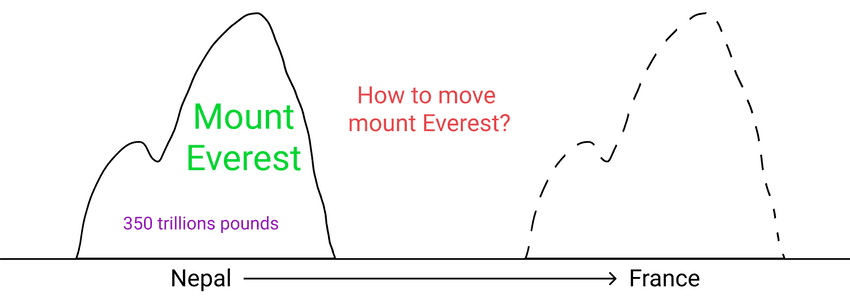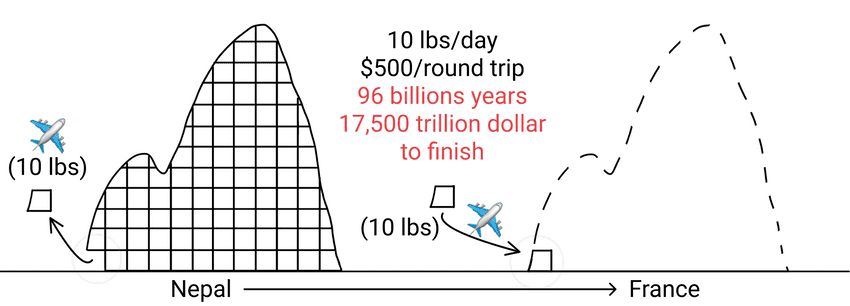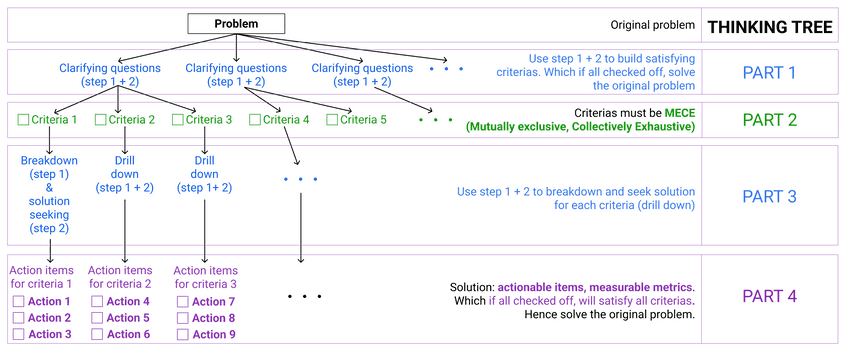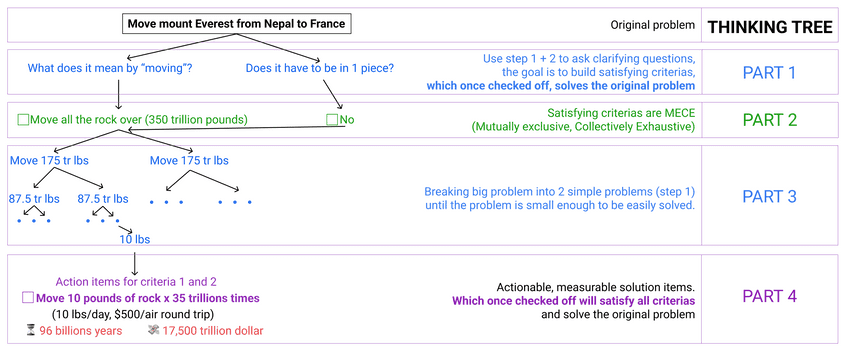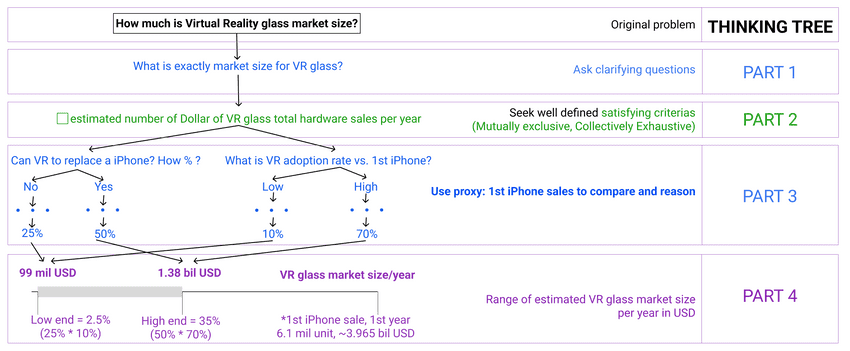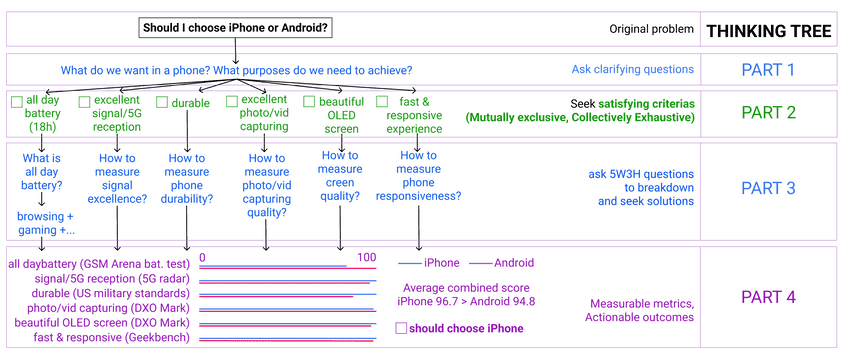This tutorial is an important part of all available courses at SESV:
- What does this skill offer?
- Why do we need this skill?
- What's the secret sauce?
- Computer: a big problem -> smaller subproblems works!
- Step 1/3 - Break complex problem into simpler problems
- Step 2/3 - Seek solution for the simple problems
- Step 3/3 - Follow the structured thinking tree
- Putting it all together, example 1: move mount Everest
- Putting it all together, example 2: VR glass market size
- Putting it all together, example 3: iPhone or Android?
- Problem complexity comparison
- Common mistakes
- Key takeaways
- Becoming a problem solving machine
What does this skill offer?
Systematic way to create high quality decisions and solutions for any problems.
- This skill is widely used by senior managers in big companies and management consultants.
- This skill is logical inference driven as opposed to hypothesis driven (popular with consultants).
- For management consultants or consultants-to-be watching this, both methods work but one might take more time than the other. Hypothesis driven might shorten the time if you have a lot of experience and a good hunch (your hypothesis is close to a real life problem). The other opposite is also true. If you have a bad hunch, you'll have to try a lot more hypotheses, which takes more time. Whereas with logical inference driven, if your problem breaking down steps are logical and MECE, your time and thought is focused on solving the problem, hence little to no time wasted.
- Try to answer these example problems: How to move mount Everest? How much is the Virtual Reality glass market size? Should I choose iPhone or Android?
Why do we need this skill?
- We make decisions/solutions all the time, in work and life. But we're not sure if it's a good one.
- Good decisions/solutions are important! Because they make you lose/gain money/time.
- This skill teaches how to create good, high quality decisions/solutions and drastically improves your work/life.
- To have metrics and measure the effectiveness of the outcomes after the decision/solution.
- Overall, it helps you to become smarter in solving problems or just simply smarter.
What's the secret sauce?
- Solve any problem. It's an impressive claim. We'll see no less impressive proofs.
- Secret: logically divide a big, complex problem into multiple, smaller, solvable subproblems.
- The more complex the big problem is, the more subproblems there are to be solved.
- To use this method, you have to be logical and diligent.
- Being logical and diligent has been helping humans to achieve wonderful things.
- You will soon realize that your problem, or any problem is not hard to solve. It's just that you might not have enough time. And the actual hard part is having enough time to solve it.
Computer: a big problem -> smaller subproblems works!
- Computer innovation: simple, multiple subproblems combined to create a complex product.
- Problem solving: complex problem broken down to small, logical, simple, solvable subproblems.
-
Similarity:
- Each combination or breakdown step is logical.
- The more complex the original problem is, the more simple subproblems it will have.
- The more simple subproblems you/computer can solve within a given time, the more resourceful and capable you/computer are/is.
- We compare the ability to handle complex problems of a computer by Floating Point Operation (example: additions, subtractions ...) Per Second (FLOPS). For example: Fugaku 442 PetaFLOPS (442 x 10^15), Summit 148.6 PetaFLOPS (148.6 x 10^15). Then we say Fugaku can handle more complex problems than Summit within the same given time. Note that they never mention how complicated a problem is. They mention how much more simple problems can a computer solve (add/subtract ...) than the other.
Breaking down complex problems into easy to solve subproblems works very well for computers and should for you. Do you think your problem is harder than making piles of aluminum, copper, gold and sand talk? I rarely think so. Let's learn how to use this method to solve your problems.
Step 1/3 - Break complex problem into simpler problems
Easy steps to breakdown:
- Logically ask questions that break the problem into 2 (or more) simpler problems.
- Make sure simpler problems are MECE (Mutual Exclusive, Collectively Exhaustive).
- Keep breaking down problems until it's easy to solve.
Questions to ask, use 5W3H:
- What? When? Where? Why? Who?
- How (method)? How (quantity)? How (quality)?
You will (almost) always be able to break down problems into simpler problems because problems created by humans, by nature, are already a combination of smaller, simpler subproblems. Example: building houses, building cars, making phones, ...
Step 2/3 - Seek solution for the simple problems
Simple problem = solvable. If not solvable -> repeat step 1.
Your answer must be:
- Analytical = fact,data driven + logical
- Based on sensible assumptions (based on known, similar facts), if data does not exist (assumptions are usually used in market estimation problems).
Step 3/3 - Follow the structured thinking tree
- Thinking tree is the tree used to record your thinking process. The longer the tree, the more complex the problem. There'll be a lot of information. Without the tree, you'll be lost.
- Tree: problem -> (part 1) clarifying questions -> (part 2) satisfying criterias (MECE) - most problem solving fails at this part -> (part 3) drill down -> (part 4) solution action items
- Most daily work/life problems only take 2 - 4 A4 pages thinking tree to have a good, high quality decision/solution.
Putting it all together, example 1: move mount Everest
This example is meant to show how powerful & how breaking down works.
Putting it all together, example 2: VR glass market size
This example is meant to show how to solve problems when data is not available: use similar subjects to compare and reason.
Putting it all together, example 3: iPhone or Android?
This example is meant to show how to solve making better choice problems: compare measurable criterias.
Problem complexity comparison
- The complexity of a problem depends on how much information you need to digest to solve the problem. Complex problems require a huge amount of data consumption.
- 50% requires 1 - 3 pages of a thinking tree - daily life questions: what to eat for dinner? Should I learn how to swim?
- 30% requires 3 - 100 pages of a thinking tree - work, academic related tasks: should I choose this method over that method? Which is the best solution for this homework?
- 10% requires 100+ pages of a thinking tree - executive, million dollar decision: should we develop a new web browser to replace Chrome? How to solve world hunger?
- 10% requires 1000+ pages of a thinking tree - problems that humans are still solving.
- Big problem needs big resources to implement the solutions. For example: you can't feed the world (solving world hunger) just by yourself.
Common mistakes
- Can you solve any problems now? YES. Can you solve any problem efficiently? Maybe/Maybe NOT. You can't solve problems fast if you don't have any expertise in them. For example, if you work in software but want to design a new opera house for Sydney, your thinking tree must be thousands of pages long, containing 4 years of learning and a few more years of practicing in civil engineering. In the end, you can, it just might take longer than someone who's already in the field.
- Jumping into finding the solution immediately -> wrong. Most problem statements are vague. You have to define the MECE satisfying criterias first, then seek solutions for each criteria (drill down).
- Do not write down the thinking tree -> wrong. You will be lost because there is so much information, your brain can't remember it all.
Key takeaways
- Simple yet powerful, structured method to solve problems: problem -> clarifying questions -> satisfying criterias (MECE) -> drill down -> solution action items
- TIME is the real & true limited resource. Money is a useful resource because it can buy you more time (from other people). Your time is precious, use it wisely.
- You'll soon realize (almost) everything is solvable. And the solution you seek is actually the most optimal solution to achieve your goals with less resources, meaning using less time and money.
- You now possess a tool of senior executives with a possible pay grade of millions dollar/year. Can you use it to bring value to people so they'll eagerly pay you that much?
Becoming a problem solving machine
- It takes a little time to practice. Once mastered, you see the world with a whole different view.
- Solving problems is not hard. The hard part is to solve your problem within limited time and money. If you have unlimited time, everything is truly possible. You can really be anyone, do anything.
- The world is a problematic place. With this skill + your domain expertise (you must be good at at least one thing), confidently go out there, solve your problem, solve the world problems. Make it a better place for yourself and for everyone.
Real life interview questions
- Move mount Everest from Nepal to France in under 10 years.
- Move mount Everest from Nepal to France under 1 billion USD.
- Move mount Everest from Nepal to France in under 10 years and under 1 billion USD.
- List top 3 goals of your life and solve them with this skill.
